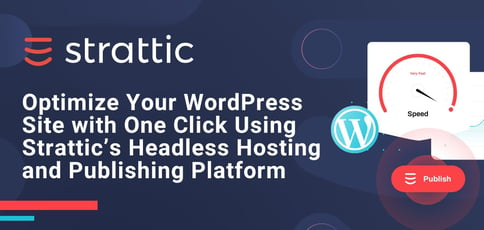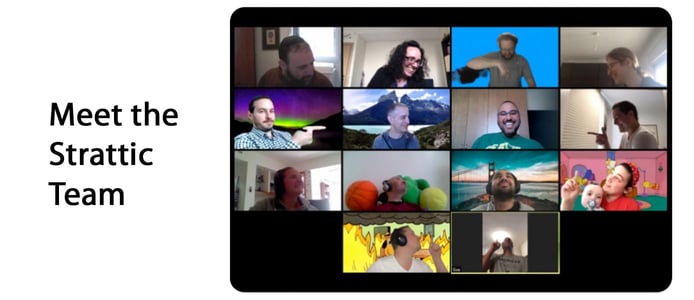
TL:DR: Strattic is a one-click hosting and publishing platform that optimizes WordPress sites by delivering them as static files and pages. The all-in-one headless solution, founded in 2018, provides instant gains in terms of security, scalability, speed, and performance. By providing a solution that meets the needs of both marketers and developers, Strattic is helping ensure the world’s most popular CMS remains as such.
Marketers across the globe become enamored with WordPress every day — and it’s easy to see why. The free, open-source solution is fed by a near-endless stream of plugins and themes, making it easy for anyone to update sites without coding knowledge.
The relationship between WordPress and developers, on the other hand, isn’t always love at first sight. As many frustrated programmers know, keeping a WordPress site up and running securely can be a challenge. All too frequently, hackers gain access to a site by breaking right through the admin login page.
The alternative — a headless CMS — eliminates that main entryway completely while adding speed, performance, and scalability benefits. Doing so, however, can make editing the site an unfamiliar experience for marketers.

Miriam Schwab, Co-Founder and CEO, told the HostingAdvice team how Strattic helps foster peace of mind.
Aiming for a best-of-both-worlds compromise between marketers and developers, Strattic’s one-click hosting and publishing platform optimizes WordPress sites by converting them to static versions of themselves. With database queries prerendered, web pages load faster and sites become more secure.
“Most developers come to Strattic for optimization purposes, but once they migrate, they almost always tell us they’ve found peace of mind,” said Miriam Schwab, Co-Founder and CEO of the company. “That means the marketing department isn’t asking them why the site is so slow. They don’t have to worry about constantly updating plugins to avoid getting hacked or a server going down because marketing ran a campaign and forgot to tell them.”
The arrangement keeps marketers happy, too. The platform allows them to carry on as usual, editing through a staging site. They can even add plugins, schedule posts, and preview sites (among other tasks) using native WordPress functionality.
Born From a WordPress Thought Leader’s Pain Points
Miriam, a self-taught developer, has significant experience in the WordPress arena and is well-known throughout the community. More than a decade ago, she founded a leading development agency in Israel.
“After building custom WordPress websites for midlevel enterprise companies for 13 years — and experiencing the ongoing and increasing pain related to managing a WordPress website — I started to think maybe WordPress was no longer the ideal solution.”
After exploring the market for alternative solutions, Miriam came across the small but reemerging world of static website-building. Static sites, also known as flat or stationary, were popular in the earlier days of the web but have evolved dramatically over the years.
“When I first started building sites, I was building static sites,” Miriam said. “It was like coming full circle, but in a more sophisticated way. I was very excited about the opportunity because a static site is everything a WordPress site is not — in a good way.”
At the same time, she acknowledged that building websites with static-site generators is not for the faint of heart and can be quite limiting to the marketers managing the site.
“I thought, why not start a WordPress static-site generator with serverless hosting? And that was where the concept for static came about,” she said. “At the time, nobody else was really exploring this avenue, and that was actually problematic — because when nobody else is doing something that you think should be done, people question whether it really needs to happen.”
Soon, other developers caught on to the trend and began to build similar products. While Strattic was no longer the only provider of its kind in the market, all players were in their infancy in terms of this new approach.
“Today, that’s still the case,” she said. “There’s a huge lack of awareness when it comes to building and deploying websites in this way, both in the WordPress industry and in general. But there’s a lot of education happening.”
Self-Service and Enterprise-Grade Solutions
Strattic offers various hosting and publishing packages to allow users of different kinds to tap into the benefits of a fast, secure, and scalable static WordPress site.
Right off the bat, customers can sign up for a free 30-day trial by creating a free Strattic account that includes one WordPress installation and a static version of the site. This option allows customers to verify how easy it is to generate a static headless WordPress site in one click.
Both monthly and annual plans are available for the Solo and Business packages, which are geared toward small businesses and growing organizations. Those interested in Enterprise plans, which feature DDoS mitigation and support, should contact sales for a quote.
All plans include a staging site, quick publishing functionality, WPML and Polylang support, 301 redirection support, and scheduled posts. Other features include Contact Form 7 and Gravity Forms support, and password-protected pages.

The Strattic team is on a mission to make the web safer and higher performing.
“We have self-serve tiers, but our proactive growth is targeted towards enterprises of different sizes,” Miriam said. “When a company is larger, and their website is very valuable to them, they’re always looking for ways to make their site faster or more secure. Once the website reaches a level where it’s mission-critical, the organization becomes very interested in investing in solutions that will do the job in a very effective way.”
W3Techs recently announced that WordPress now powers 40% of the world’s websites. As the popularity of WordPress continues to grow, Strattic will likely see a steady flow of new customers.
“That’s where all of their activity is happening now, with users who want to maximize the potential of their WordPress sites,” Miriam said.
Security, Speed, Performance, and Scalability Gains
Strattic is part of an emerging approach to web development known alternatively as Jamstack, headless, or static. For technically-oriented developers, the opportunity to convert a WordPress website to static and headless in one click provides massive value.
“If you want to get that type of architecture for an existing site, you’re going to have to throw what you have in the garbage and start from scratch. And if you start from scratch, it’s quite complicated to get a Jamstack site up and running. There’s a lot of different tooling that needs to be integrated.”
Strattic’s one-click approach allows marketers that are accustomed to their WordPress sites to maintain the status quo while developers boost security, scalability, speed, and performance.
“You get it all: Marketers get to use WordPress as usual, and developers get JAMstack static output in one click,” Miriam said. “Strattic eliminates the all-too-common situation where marketing asks for another WordPress website and the developers know they’re going to have yet another headache. Now it’s a symbiotic relationship.”
Regarding future plans, Miriam said Strattic plans to ensure the platform’s publication process is as aligned as possible with the standard WordPress experience.
“As with any static site generator, with Strattic, there’s a build process to generate the static version of the site,” she said. “We’re constantly optimizing it, making it faster and more intelligent.”
The Strattic team is currently working on further differentiating itself in that respect.
“As opposed to other static-site generators, you will get super fast published times, making the whole user experience much better. Marketing teams will really feel like they’re using WordPress in its native format. We’re solving a major problem and putting ourselves ahead of the game in a big way.”
HostingAdvice.com is a free online resource that offers valuable content and comparison services to users. To keep this resource 100% free, we receive compensation from many of the offers listed on the site. Along with key review factors, this compensation may impact how and where products appear across the site (including, for example, the order in which they appear). HostingAdvice.com does not include the entire universe of available offers. Editorial opinions expressed on the site are strictly our own and are not provided, endorsed, or approved by advertisers.
Our site is committed to publishing independent, accurate content guided by strict editorial guidelines. Before articles and reviews are published on our site, they undergo a thorough review process performed by a team of independent editors and subject-matter experts to ensure the content’s accuracy, timeliness, and impartiality. Our editorial team is separate and independent of our site’s advertisers, and the opinions they express on our site are their own. To read more about our team members and their editorial backgrounds, please visit our site’s About page.

